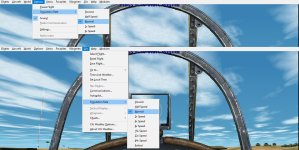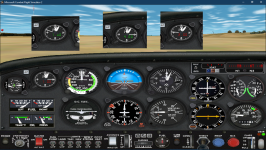-
There seems to be an uptick in Political comments in recent months. Those of us who are long time members of the site know that Political and Religious content has been banned for years. Nothing has changed. Please leave all political and religious comments out of the forums.
If you recently joined the forums you were not presented with this restriction in the terms of service. This was due to a conversion error when we went from vBulletin to Xenforo. We have updated our terms of service to reflect these corrections.
Please note any post refering to a politician will be considered political even if it is intended to be humor. Our experience is these topics have a way of dividing the forums and causing deep resentment among members. It is a poison to the community. We appreciate compliance with the rules.
The Staff of SOH
You should upgrade or use an alternative browser.
Time Compression
- Thread starter RWILLS
- Start date
RichNagel
Members +
P.S. Off topic, but another nice utility module for CFS2 by the same author, "Sim Favorites" -> http://www.mwgfx.co.uk/Cfsops/Modules/sim_favorites/sim_favorites.htm

RichNagel
Members +
Also for Martin W's Sim Favourites ut, not seen that before, so you learn something new......
Actually, CFO Weather and Sim Favorites (as well as several other handy things found here -> http://www.mwgfx.co.uk/Cfsops/Default.htm ) was created by Bill Potvin II. Martin Wright has simply archived all of Bill Potvin II's web pages (as, if I'm not mistaken, he passed several years ago).
That being said, Sim Favorites was one of his long-since gone downloads... it was no where to be found. After searching for many months I managed to find a download for the file and sent it over to Martin Wright, who added it to Bill Potvin II's archived web pages
P.S. Note that the Windows shell extension ("favorites_shellext.dll") mentioned for Sim Favorites does NOT function under the newer incarnations of WinDoZe. But, the CFS2 module works just fine within the game
I never seen it in the settings but the keys are CTRL+T or CTRL+R. It is also in the Alt key than Options as Sim Rate.
thanks
screenshot -shows it in settings, apparently with no keys assigned, however it works fine now with your CTRL+T
RichNagel
Members +
In the attached screenshot, the Time Compression indicator on the clock gauge turns green when that feature is selected for the gauge, and + and - changes the simulation rate.
That being said, two keyboard assignments that are NOT displayed within CFS2's Controller Assigmnments menu, but ARE in the CFS2.CFG configuration file increase and decrease the simulation rate on the fly (without having to press the Time Compression key, and then the + or - key).
Mine are configured for "R" and "SHIFT+R", and are in the CFS2.CFG configuration file like this:
[KEYBOARD_MAIN]
SIM_RATE_INCR=82,8
SIM_RATE_DECR=82,9
Pressing "R" increases the simulation rate, and pressing "SHIFT+R" decreases the simulation rate. When these keys are used (see attached screenshot) the Time Compression indicator on the clock gauge stays red, but the simulation rate increases and decreases when pressing these keys.
P.S. The entry in the CFS2.CFG configuration file for actually selecting the Time Compression indicator on the clock gauge is:
[KEYBOARD_MAIN]
SIM_RATE=##,##
...and if you have configured the key for CTRL+T, it will look like this:
[KEYBOARD_MAIN]
SIM_RATE=84,10
P.P.S. Sort of off-topic, but a REALLY HANDY document for determining the cryptic codes in the CFS2.CFG configuration file for keyboard presses (this is ALSO exactly the same for FS2000+++):
APPENDIX 1: List of Keyboard Codes
The keyboard sections of FS2000.CFG use Windows 'virtual keycodes' to define the keypresses being assigned. Two numbers are given, separated by a comma. The first is the virtual keycode from the list below. The second is a "shift state" indicator, thus:
8 plain key only
9 SHIFT + key
10 CNTRL + key
11 SHIFT + CNTRL + key
There are also values 40, 41, 42 and 43 - as above with 32 added. I don’t know what the 32 addition does. Experiments here seem to indicate that it makes no difference - they act the same as if the 32 hadn’t been added. (If anyone finds out, please let me know!)
Here is the list of keycodes, in code number order. NOTE that these may not all be usable in FS2K. Also, those marked with an asterisk (*) are often keyboard specific. The values shown are for the UK keyboard. Please see the text for how to identify keycodes for specific keys on your keyboard.
3 Ctrl Break (needs shift state = 10)
8 Backspace
9 Tab
12 NumPad 5 (NumLock OFF)
13 Enter
19 Pause
20 Caps lock (usable with Shift but not with Cntrl)
27 Escape
32 Space bar
33 Page Up
34 Page Down
35 End
36 Home
37 Left arrow
38 Up arrow
39 Right arrow
40 Down arrow
44 Print screen (not usable)
45 Insert
46 Delete
48 0 on main keyboard
49 1 on main keyboard
50 2 on main keyboard
51 3 on main keyboard
52 4 on main keyboard
53 5 on main keyboard
54 6 on main keyboard
55 7 on main keyboard
56 8 on main keyboard
57 9 on main keyboard
65 A
66 B
67 C
68 D
69 E
70 F
71 G
72 H
73 I
74 J
75 K
76 L
77 M
78 N
79 O
80 P
81 Q
82 R
83 S
84 T
85 U
86 V
87 W
88 X
89 Y
90 Z
96 NumPad 0 (NumLock ON)
97 NumPad 1 (NumLock ON)
98 NumPad 2 (NumLock ON)
99 NumPad 3 (NumLock ON)
100 NumPad 4 (NumLock ON)
101 NumPad 5 (NumLock ON)
102 NumPad 6 (NumLock ON)
103 NumPad 7 (NumLock ON)
104 NumPad 8 (NumLock ON)
105 NumPad 9 (NumLock ON)
106 NumPad *
107 NumPad +
109 NumPad -
110 NumPad .
111 NumPad /
112 F1
113 F2
114 F3
115 F4
116 F5
117 F6
118 F7
119 F8
120 F9
121 F10
122 F11
123 F12
135 NumPad Enter
144 NumLock
145 ScrollLock
186 ; : Key*
187 = + Key*
188 , < Key*
189 - _ Key*
190 . > Key*
191 / ? Key*
192 # ~ Key*
219 [ { Key*
220 \ | Key*
221 ] } Key*
222 ' @ Key*
223 ` ¬ ¦ Key*
* These keys will vary from keyboard to keyboard. The graphics indicated are those shown on my UK keyboard. It is possible that keys in the same relative position on the keyboard will respond similarly, so here is a positional description for those of you without UK keyboards. This list is in left-to-right, top down order, scanning the keyboard:
223 ` ¬ ¦ is top left, just left of the main keyboard 1 key
189 - _ is also in the top row, just to the right of the 0 key
187 = + is to the right of 189
219 [{ is in the 2nd row down, to the right of the alpha keys.
221 ]} is to the right of 219
186 ; : is in the 3rd row down, to the right of the alpha keys.
222 ' @ is to the right of 186
192 # ~ is to the right of 222 (tucked in with the Enter key)
220 \ | is in the 4th row down, to the left of all the alpha keys
188 , < is also in the 4th row down, to the right of the alpha keys
190 . > is to the right of 188
191 / ? is to the right of 190
bearcat241
SOH-CM-2023
Try 8 on 8 quick combat in 2x-4x. Its more intense than flying jets in any guns-only Korean war sim action...and the enemy AI are waaay more aggressive and lethal.
RichNagel
Members +
But you don't want to be in any TC setting beyond normal speed when the shooting starts at your objective. Try 8 on 8 quick combat in 2x-4x. Its more intense than flying jets in any guns-only Korean war sim action...and the enemy AI are waaay more aggressive and lethal.
Understatement of the year LOL!
Sarg Willy
SOH-CM-2014
but the catch 22 -- is the Dp files do not comply , it impacts the velocity , slowing down the sim rate 0.90%
reduces velocity , your aim point drops , and faster 1.25 raises velocity , Interesting was the fact the loop
rate checks , remained constant = 1.0 sim rate ,
